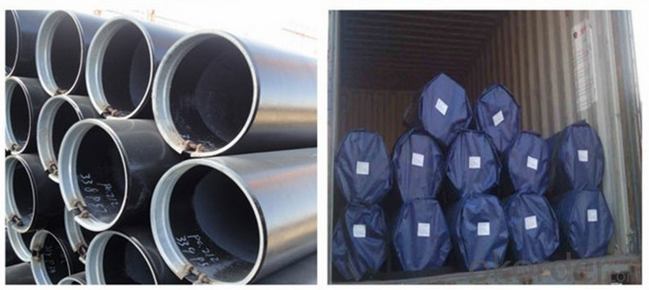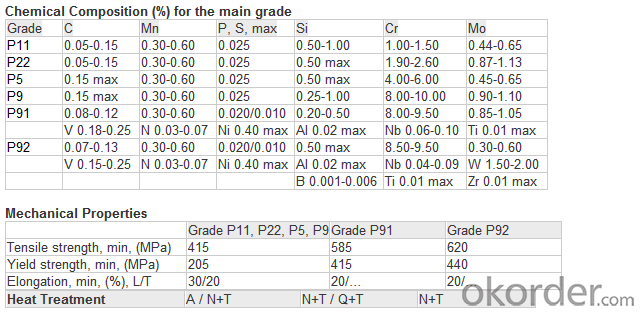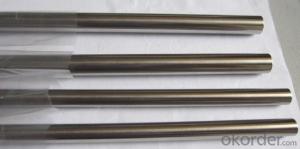stainless steel free cutting 303 stainless steel rods
- Loading Port:
- Shanghai
- Payment Terms:
- TT OR LC
- Min Order Qty:
- 1000 kg
- Supply Capability:
- 10000 kg/month
OKorder Service Pledge
OKorder Financial Service
You Might Also Like
Packaging Detail: | Bundle or Container or as per customers requirement. |
Delivery Detail: | within 25 days after we receive an irrevocable L/Cor 30% deposit |
ASTM A335 Seamless Alloy-Steel Pipe
Standard: BS 1139, BS 3059-2, JIS G3454-2007
Grade: 10#-45#, 15NiCuMoNb5, 10Cr9Mo1VNb
Detailed introduction to ASTM A335 seamless alloy steel pipe:
ASTM A335 seamless alloy steel pipe


FAQ:
1) why you chose us ?
Professional Manufacturer and supplier of Steel pipe
More than 14 years’ professional producing experience
We can get the lowest ex-factory prices. The price are quite reasonable and it is lower than our commercial peers. also, we can guarantee the qualities of our products.
BV, ISO certificates and SGS test can be provided to assure the quality of our products.
2) Our minimum order quantity:
10 Metric Tons or one 20ft or 40ft Container.
3) How about the Delivery Time?
The steel pipe will be produced since we getting your deposit by T/T or Your original L/C. For normal size, some stocks in our factory now, we can supply once you need.
4)What kind of payment does your company support?
T/T, 100% L/C at sight, Cash, Western Union are all accepted.
5) Do you charge for the samples?
According to our company principle, we just charge for samples, you pay for the freight /courier charge.
6) Main market:
Mid East, South America, Africa, Southeast Asia, India etc
- Q:Are stainless steel pipes resistant to acidic solutions?
- Yes, stainless steel pipes are generally resistant to acidic solutions.
- Q:Are stainless steel pipes suitable for underground irrigation systems?
- Yes, stainless steel pipes are suitable for underground irrigation systems. Stainless steel is corrosion-resistant, durable, and can withstand various environmental conditions, making it an excellent choice for underground applications.
- Q:What is the difference between Type 409 and Type 410 stainless steel pipes?
- Type 409 stainless steel pipes are commonly used in automotive exhaust systems due to their excellent resistance to high temperatures and corrosion. On the other hand, Type 410 stainless steel pipes are known for their higher strength and hardness, making them suitable for applications that require increased durability and resistance to wear and abrasion.
- Q:What is the difference between 304Cb and 316Cb stainless steel pipes?
- The chemical composition and properties differentiate 304Cb and 316Cb stainless steel pipes. 304Cb stainless steel is an austenitic alloy with chromium, nickel, and a small amount of niobium. The niobium improves its resistance to intergranular corrosion, making it suitable for applications in food processing, chemical and petrochemical industries, and architecture. On the contrary, 316Cb stainless steel, also an austenitic alloy, contains chromium, nickel, and a higher proportion of molybdenum. The increased molybdenum content provides superior resistance to corrosion and pitting in chloride environments. Therefore, 316Cb stainless steel pipes are ideal for marine environments or coastal areas where exposure to saltwater or corrosive substances is common. In conclusion, both 304Cb and 316Cb stainless steel pipes are excellent options for various applications. However, 316Cb stainless steel offers enhanced corrosion resistance in chloride environments due to its higher molybdenum content. The choice between the two depends on the specific requirements and surroundings of the application.
- Q:Can stainless steel pipes be insulated with polyetherimide?
- Yes, stainless steel pipes can be insulated with polyetherimide. Polyetherimide (PEI) is a high-performance thermoplastic that has excellent thermal stability and insulating properties. It can be used as an insulation material for various applications, including pipe insulation. PEI offers good resistance to heat, chemicals, and electrical conductivity, making it suitable for insulating stainless steel pipes in different industries such as oil and gas, chemical processing, and aerospace. Additionally, PEI has a high glass transition temperature, which allows it to withstand high temperatures without melting or deforming, further enhancing its suitability for insulating stainless steel pipes.
- Q:Can stainless steel pipes be threaded with NPT threads?
- Yes, stainless steel pipes can be threaded with NPT (National Pipe Thread) threads.
- Q:What is the average weight of a stainless steel pipe?
- The average weight of a stainless steel pipe can vary depending on its diameter, thickness, and length.
- Q:What are the common industry standards for stainless steel pipes?
- The common industry standards for stainless steel pipes include ASTM A312/A312M for seamless and welded pipes, ASTM A269 for seamless and welded tubes, and ASME B36.19M for stainless steel pipe dimensions. These standards ensure the quality, dimensions, and performance of stainless steel pipes in various applications.
- Q:Can stainless steel pipes be used in the oil and gas industry?
- Yes, stainless steel pipes can be used in the oil and gas industry. Stainless steel is highly resistant to corrosion and can withstand high pressure and extreme temperature conditions, making it a suitable material for transporting oil and gas. It also has excellent durability and reliability, making it a preferred choice for various applications in the industry.
- Q:Can stainless steel pipes be sandblasted?
- Stainless steel pipes are capable of undergoing sandblasting, which is a widely utilized technique for cleansing, smoothing, or adding texture to the surfaces of various materials, including stainless steel. This method involves expelling fine particles or abrasive substances at high velocities to eliminate impurities or achieve a desired appearance. By means of sandblasting, it is possible to effectively eliminate rust, scale, paint, or other coatings from stainless steel pipes, thereby preparing them for subsequent treatments such as painting or coating. In order to prevent any damage to the stainless steel surface, it is crucial to carefully consider the type and size of abrasive material employed during the sandblasting process. Furthermore, it is essential to adhere to appropriate safety precautions to ensure the protection of workers from the potential hazards associated with sandblasting.
1. Manufacturer Overview |
|
|---|---|
| Location | |
| Year Established | |
| Annual Output Value | |
| Main Markets | |
| Company Certifications | |
2. Manufacturer Certificates |
|
|---|---|
| a) Certification Name | |
| Range | |
| Reference | |
| Validity Period | |
3. Manufacturer Capability |
|
|---|---|
| a)Trade Capacity | |
| Nearest Port | |
| Export Percentage | |
| No.of Employees in Trade Department | |
| Language Spoken: | |
| b)Factory Information | |
| Factory Size: | |
| No. of Production Lines | |
| Contract Manufacturing | |
| Product Price Range | |
Send your message to us
stainless steel free cutting 303 stainless steel rods
- Loading Port:
- Shanghai
- Payment Terms:
- TT OR LC
- Min Order Qty:
- 1000 kg
- Supply Capability:
- 10000 kg/month
OKorder Service Pledge
OKorder Financial Service
Similar products
New products
Hot products
Related keywords





























